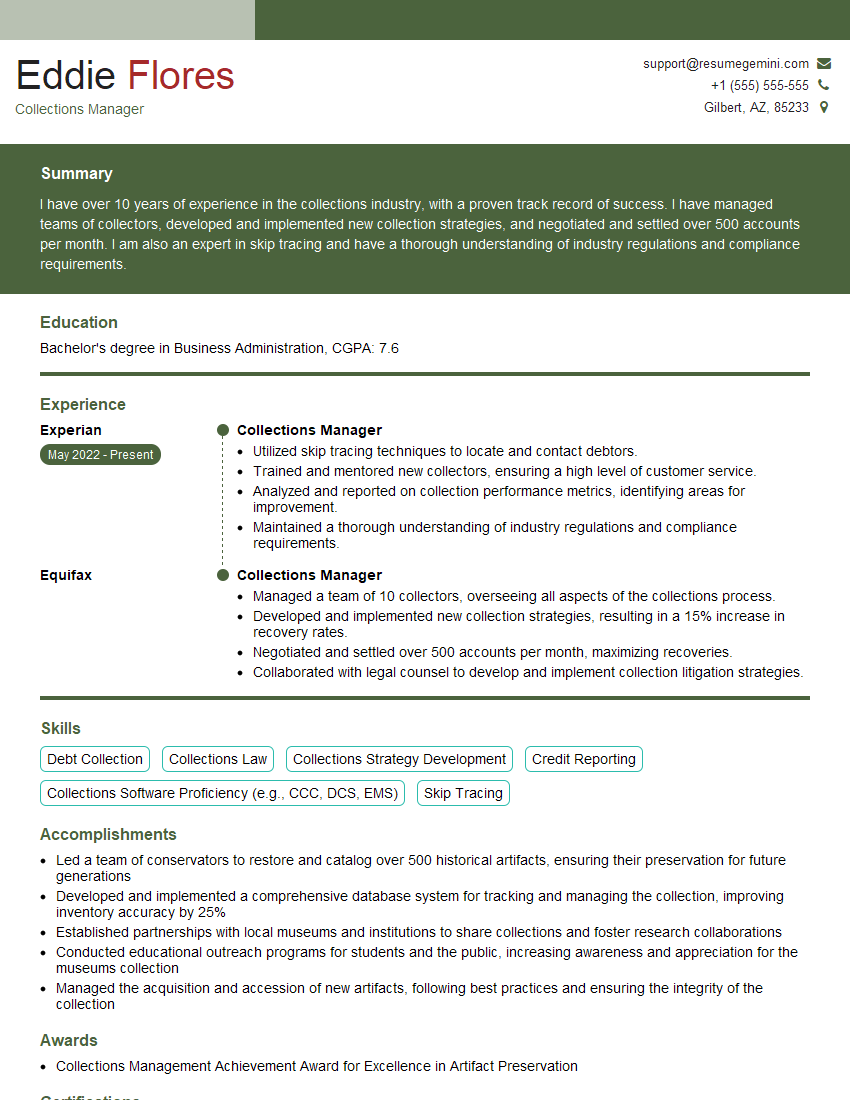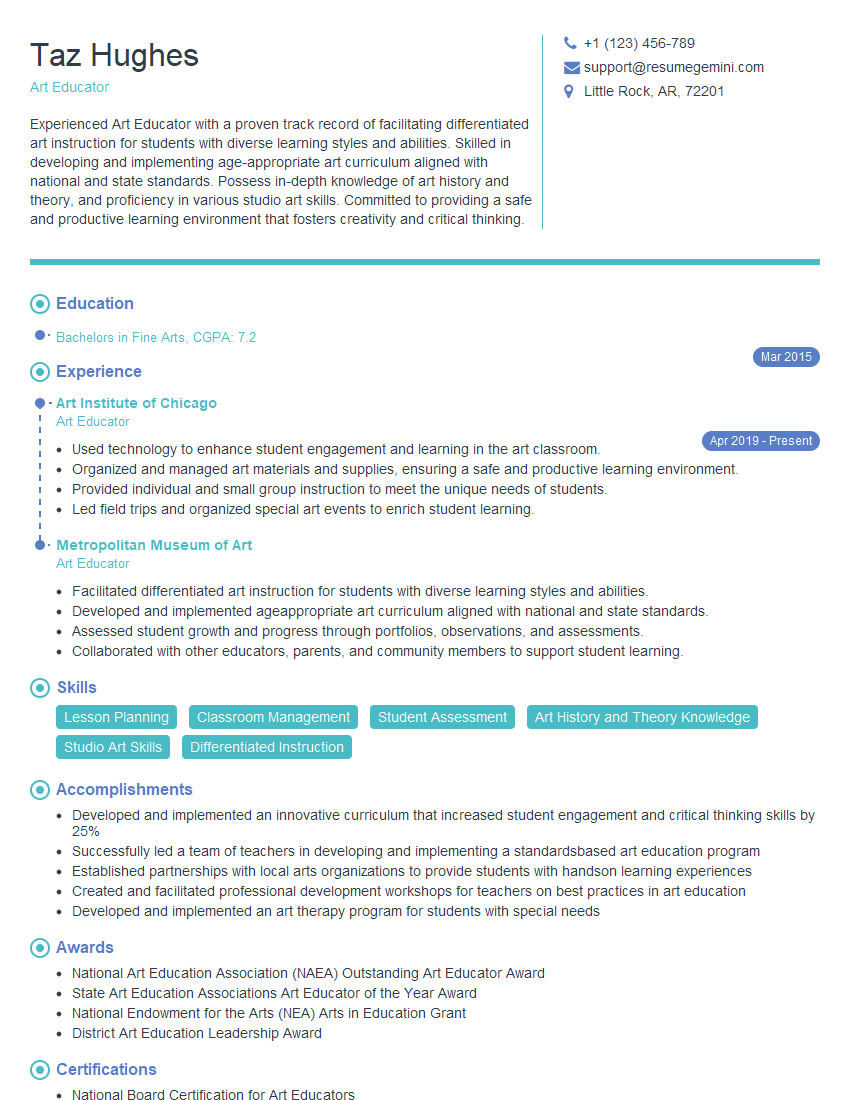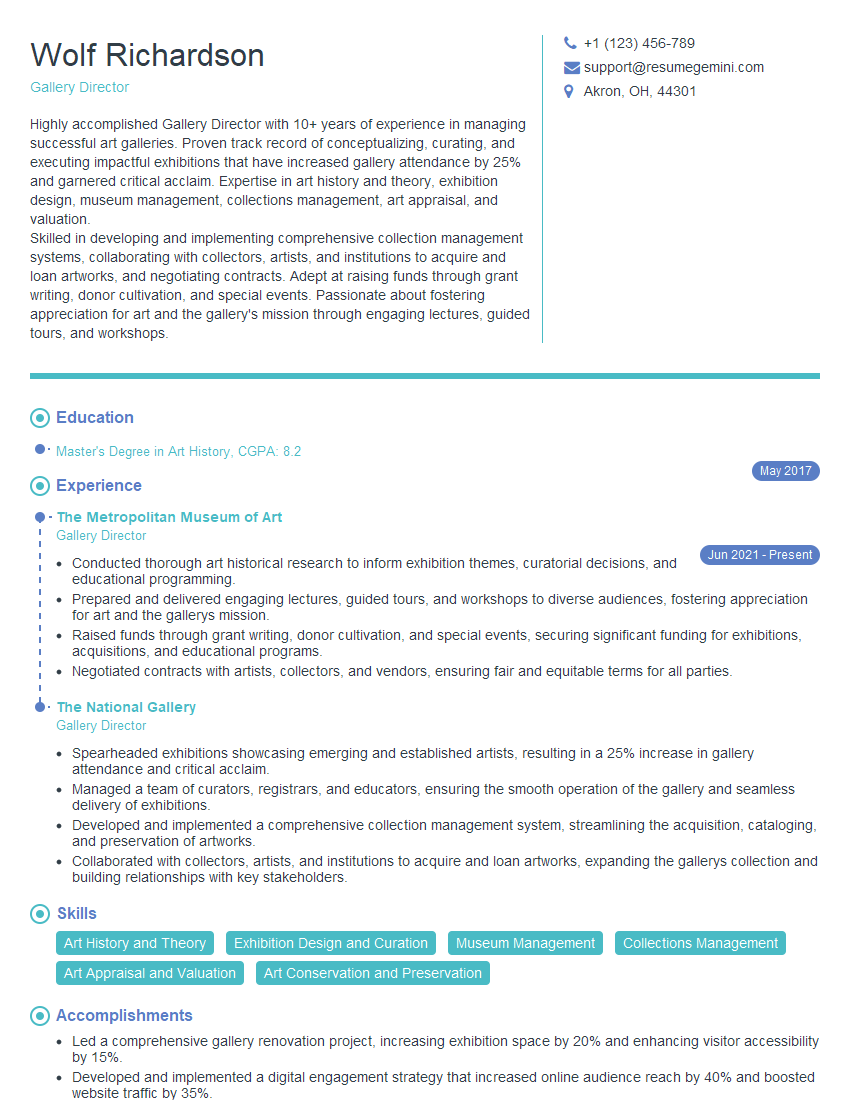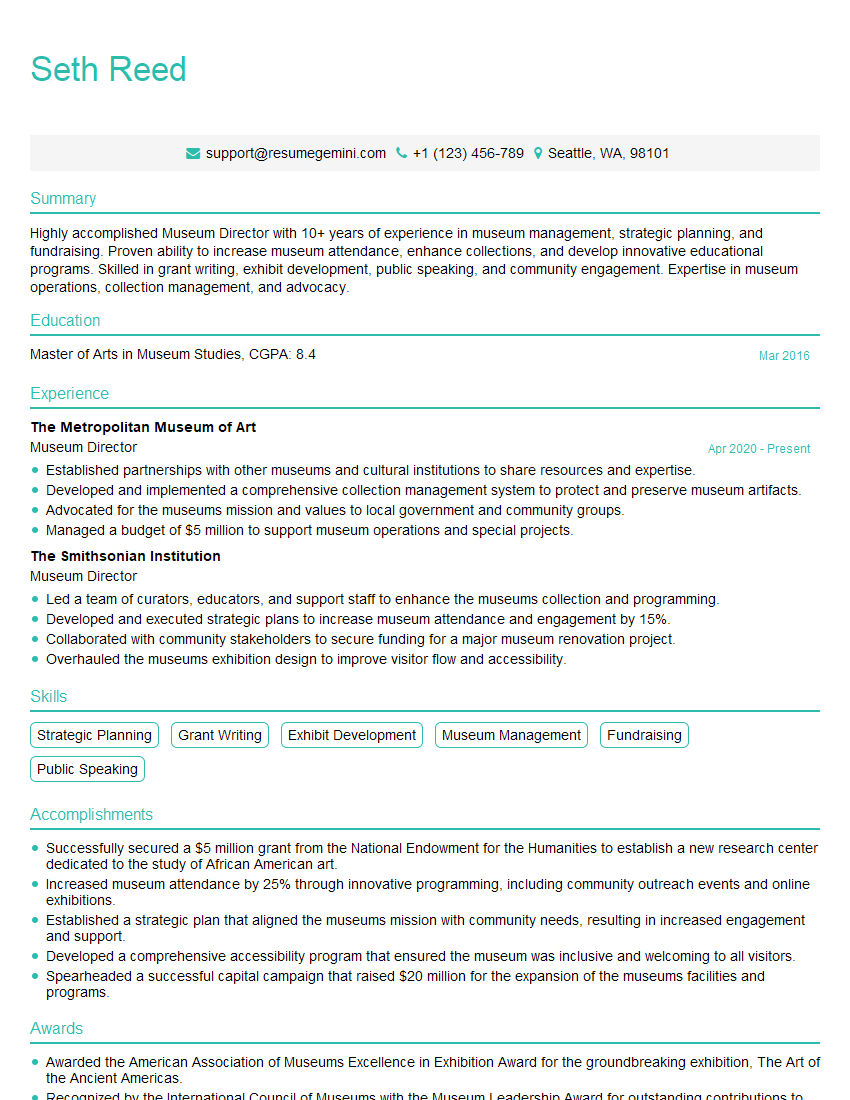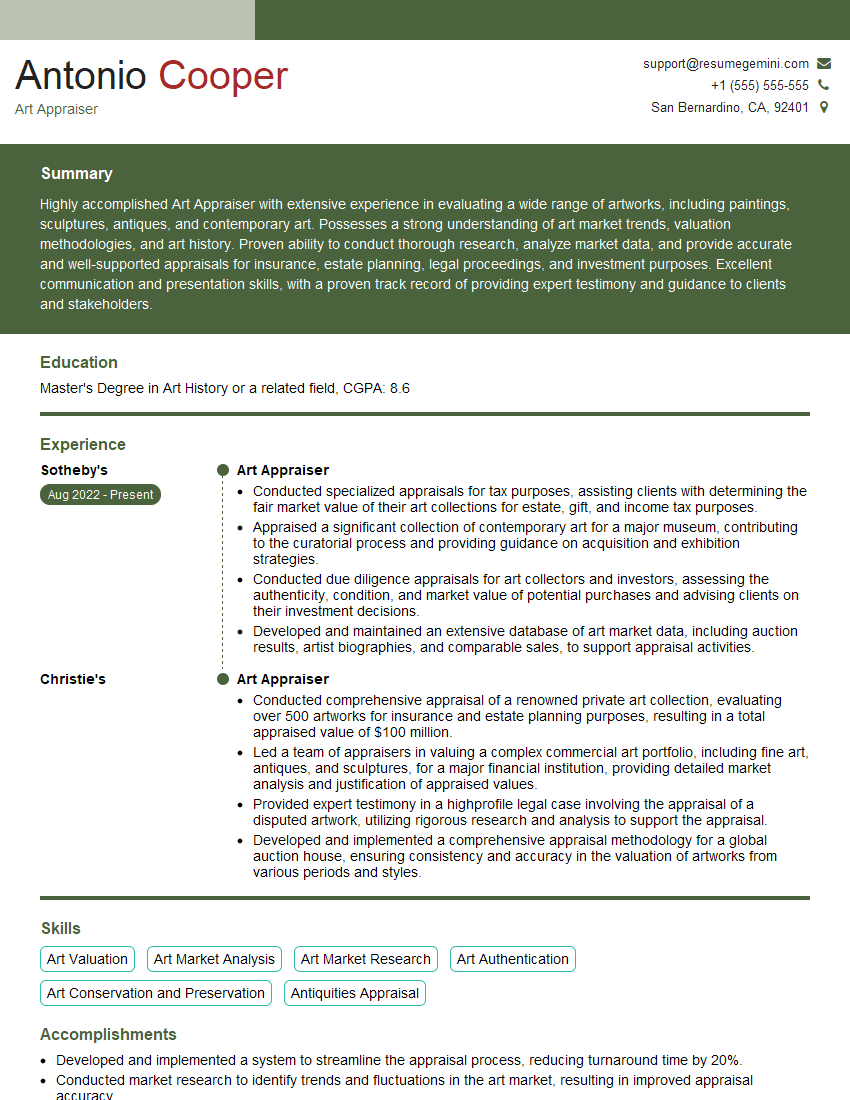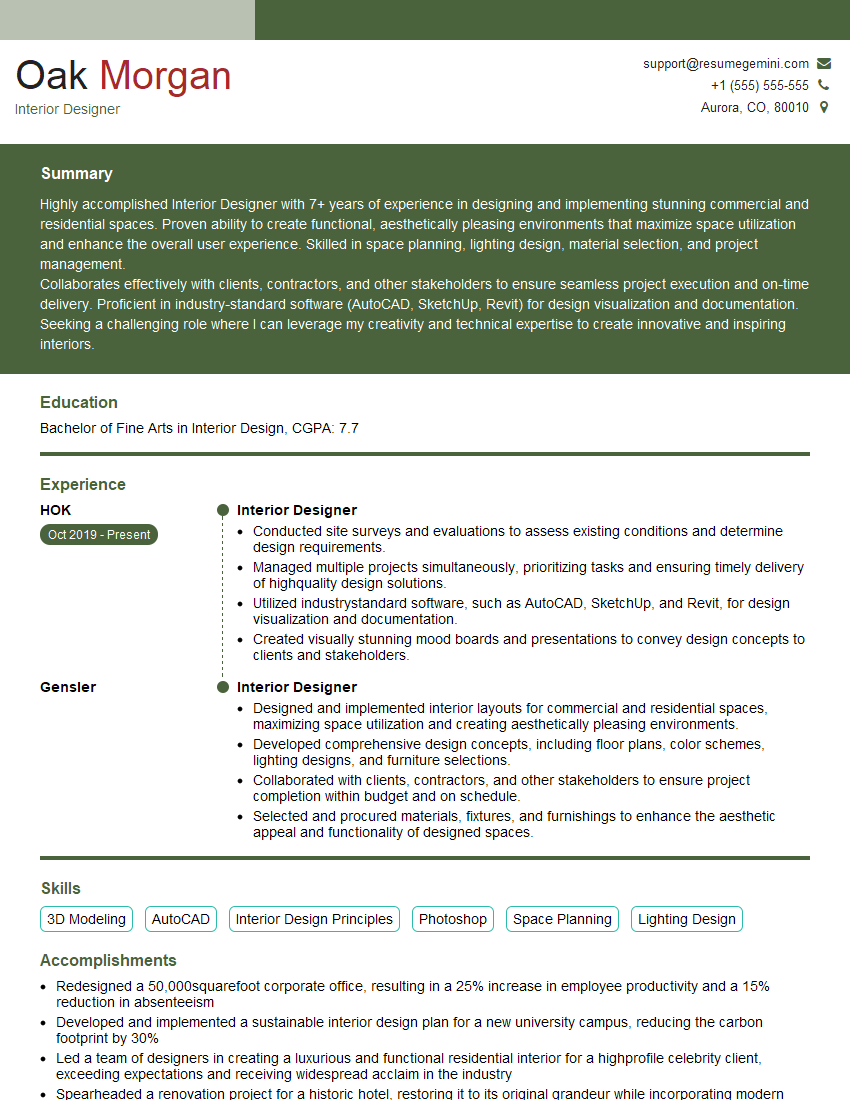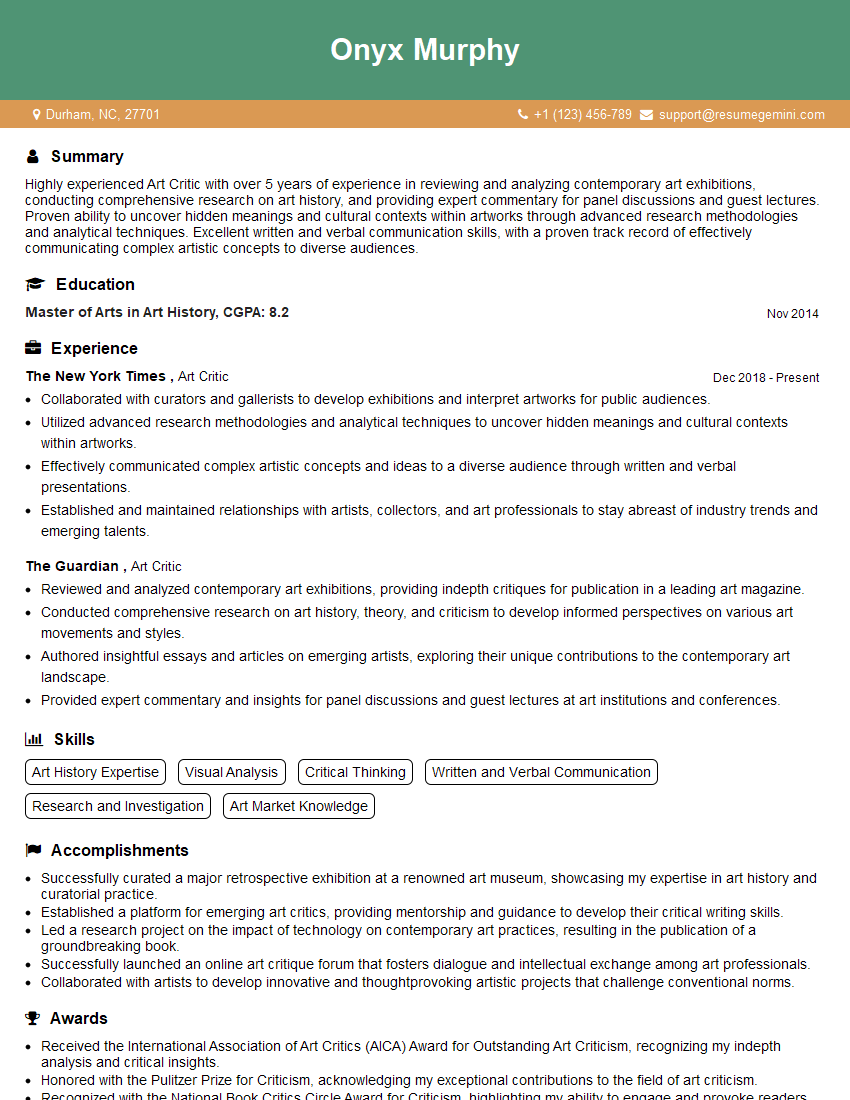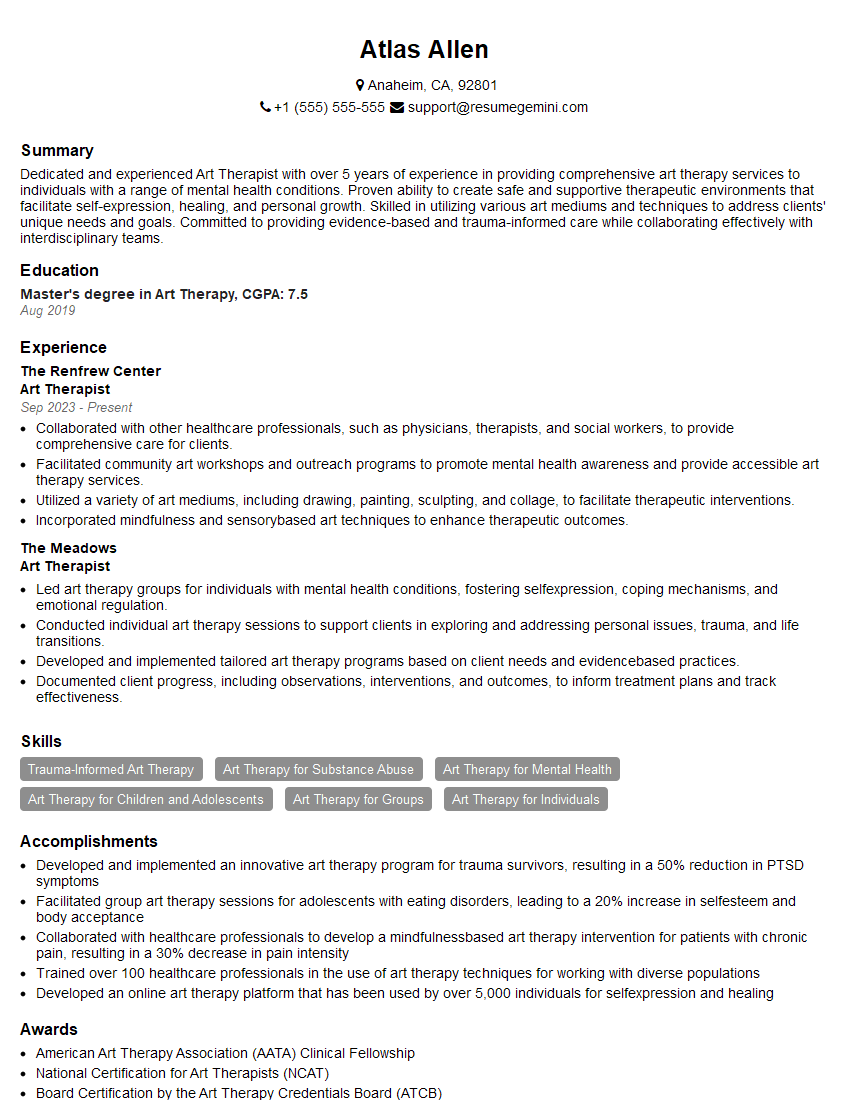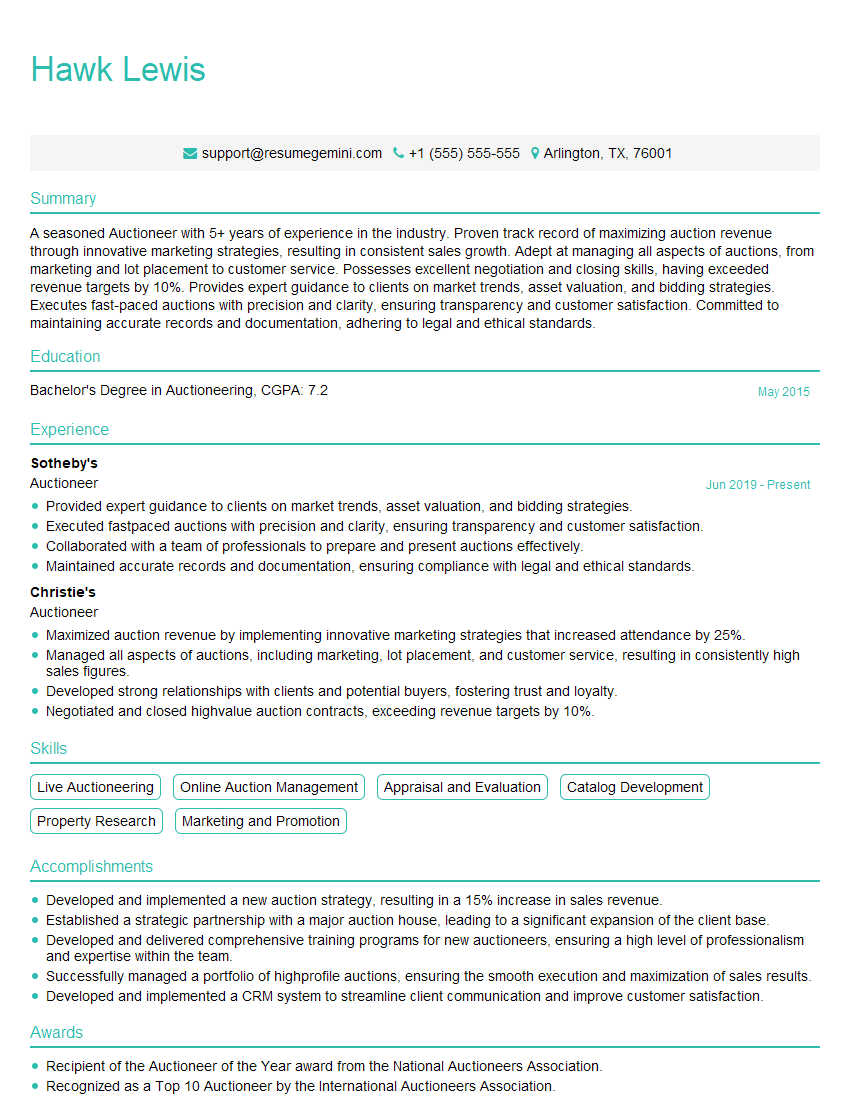Are you ready to stand out in your next interview? Understanding and preparing for Knowledge of art theory and aesthetics interview questions is a game-changer. In this blog, we’ve compiled key questions and expert advice to help you showcase your skills with confidence and precision. Let’s get started on your journey to acing the interview.
Questions Asked in Knowledge of art theory and aesthetics Interview
Q 1. Explain the difference between formalism and contextualism in art criticism.
Formalism and contextualism represent two fundamentally different approaches to art criticism. Formalism focuses solely on the artwork’s intrinsic qualities – its form, composition, style, and aesthetic elements – to determine its value and meaning. Contextualism, on the other hand, considers the artwork within its broader historical, social, cultural, and political context to understand its significance.
Think of it like this: a formalist might analyze a painting by focusing on brushstrokes, color palette, and spatial arrangement, regardless of the artist’s biography or the historical period. A contextualist, however, would consider all these aspects *plus* the artist’s intentions, the societal norms of the time, and the painting’s reception and influence. For example, analyzing a Picasso painting through a formalist lens would mean focusing on its cubist techniques, while a contextualist approach might explore its relationship to early 20th-century societal upheaval in Europe. The two approaches aren’t mutually exclusive; a comprehensive analysis often incorporates both.
Q 2. Describe the key tenets of Immanuel Kant’s aesthetics.
Immanuel Kant’s aesthetics center on the concept of ‘disinterested judgment.’ This means that our experience of beauty is not driven by personal desires or practical considerations but is rather a purely contemplative and objective appreciation of the object’s form. He distinguishes between beautiful objects and sublime experiences. The beautiful is characterized by harmony, proportion, and order, evoking pleasure and satisfaction. The sublime, however, arises from experiencing something that is overwhelmingly vast, powerful, or terrifying, resulting in a feeling of awe and even fear. Kant emphasizes that the judgment of beauty is subjective yet universal – meaning our personal experience of beauty can still be valid even if it differs from others, because it points towards a shared human capacity for aesthetic appreciation.
Kant’s work had a profound impact on subsequent aesthetic theories. His emphasis on the role of the observer’s mental faculties in shaping the experience of beauty highlights the active and cognitive role we play in engaging with art.
Q 3. Analyze the impact of the Renaissance on Western art.
The Renaissance (roughly 14th-16th centuries) revolutionized Western art in profound ways. It marked a shift away from the stylized, symbolic representations of the Medieval period towards a renewed focus on realism, humanism, and classical ideals.
- Realism and Humanism: Renaissance artists strived for accurate depictions of the human form and natural world, driven by a renewed interest in classical Greek and Roman art and philosophy. This led to a focus on anatomical accuracy, perspective, and realistic portrayal of light and shadow (chiaroscuro).
- Classical Influence: Renaissance artists looked to classical antiquity for inspiration, emulating the idealized forms and balanced compositions found in ancient sculptures and architecture.
- Patronage and Artistic Flourishing: The rise of wealthy patrons, such as the Medici family in Florence, provided financial support and commissioned artists to create magnificent works, leading to an explosion of artistic innovation.
- Technical Innovations: New techniques like linear perspective and oil painting allowed artists to create more realistic and detailed works.
Examples such as Leonardo da Vinci’s Mona Lisa and Michelangelo’s David exemplify the Renaissance’s emphasis on realism, humanism, and mastery of technique. The Renaissance’s impact on art is still felt today; its emphasis on human form, perspective, and the power of artistic expression continues to inform contemporary artistic practice.
Q 4. Compare and contrast the artistic styles of Impressionism and Post-Impressionism.
Impressionism and Post-Impressionism are closely related yet distinct art movements that emerged in France during the late 19th century. Impressionism, characterized by its focus on capturing fleeting moments and the effects of light, emphasized visible brushstrokes and a spontaneous style. Post-Impressionism, while building upon Impressionism’s innovations, moved beyond its limitations by exploring individual expression, symbolism, and structural experimentation.
- Impressionism: Focused on capturing the visual impression of a scene, often outdoors, through quick, visible brushstrokes and vibrant colors. Examples include Monet’s Impression, soleil levant and Renoir’s depictions of Parisian life. Emphasis was on light and its effects on color and form.
- Post-Impressionism: Reacted against Impressionism’s perceived lack of structure and emotional depth. Artists like Van Gogh, Cézanne, and Gauguin emphasized personal expression, using bold colors and distorted forms to convey emotion and symbolism. Van Gogh’s expressive brushwork and Gauguin’s stylized forms illustrate this departure from Impressionism’s focus on objective representation.
In essence, Impressionism was about capturing a fleeting moment objectively, while Post-Impressionism used Impressionist techniques to express subjective emotions and ideas, often using the structure and form of the art itself to convey meaning.
Q 5. Discuss the role of patronage in the development of art throughout history.
Patronage has played a pivotal role in the development of art throughout history. Patrons, whether they were wealthy individuals, the Church, or states, provided the financial resources necessary for artists to create their work. This relationship significantly shaped artistic styles, subject matter, and the very existence of art as a profession.
In the Renaissance, wealthy families like the Medici commissioned works that reflected their power and influence. The Church was a major patron during the medieval period, commissioning religious art that served to convey religious narratives and reinforce religious beliefs. Royal courts throughout history also served as significant patrons, commissioning portraits, religious works, and other art that showcased the ruler’s power and legitimacy. The nature of patronage influenced artistic styles: a commissioned portrait for a wealthy merchant would differ significantly from a religious altarpiece created for a monastery. Today, patronage takes various forms, including private collectors, museums, and government grants, though the fundamental principle remains: financial support allows artists to create and for their work to reach an audience.
Q 6. Explain the concept of ‘the sublime’ in art and aesthetics.
The sublime, in art and aesthetics, refers to an experience of awe, wonder, and even terror in the face of something vast, powerful, or overwhelming. It’s not simply beauty; it’s an experience that transcends the boundaries of human comprehension, often evoking a sense of both fascination and fear. This could be triggered by the grandeur of nature (a towering mountain range, a stormy sea), the vastness of space, or even certain forms of art that evoke intense emotion.
Think of Caspar David Friedrich’s landscapes, which often depict vast, awe-inspiring natural scenes that simultaneously inspire reverence and a sense of human insignificance. The sublime doesn’t necessarily need to be visually pleasing; its power lies in its capacity to elicit a profound emotional and psychological response, challenging our sense of scale and perspective. The experience of the sublime has been explored in literature and philosophy as well as in visual arts, highlighting its lasting impact on our understanding of art and human experience.
Q 7. How has the concept of beauty evolved throughout different art historical periods?
The concept of beauty has evolved significantly throughout art history, reflecting changing cultural values, philosophical ideas, and technological developments.
- Classical Antiquity: Emphasized idealized forms, balance, and harmony, as seen in Greek sculptures. Beauty was associated with perfection and mathematical proportion.
- Medieval Period: Beauty was often linked to religious devotion and spiritual symbolism. Stylized representations, with less emphasis on realism, were common.
- Renaissance: Reintroduced classical ideals of balance and harmony but also emphasized realism and humanism, capturing individual beauty and anatomical accuracy.
- 18th and 19th Centuries: Saw a rise of diverse aesthetic ideals. The sublime was explored alongside the beautiful, and the Romantic movement emphasized emotional expressiveness over strict adherence to classical canons.
- 20th and 21st Centuries: Modern and contemporary art challenges traditional notions of beauty. Abstract art, conceptual art, and performance art prioritize concepts, ideas, and the process of creation over traditional aesthetic standards. The definition of beauty becomes more fluid and subjective, reflecting the diversity of artistic expression and cultural values.
The evolution of beauty underscores the fact that it’s not a fixed or objective concept but rather a cultural construct that is continually shaped and reshaped by historical context and artistic innovation.
Q 8. What are some key ethical considerations in art conservation?
Ethical considerations in art conservation are paramount, balancing the preservation of cultural heritage with the evolving understanding of best practices. A key concern is the reversibility of treatments. Ideally, any intervention should be reversible, allowing future conservators to undo potentially damaging procedures. This necessitates meticulous documentation of every step in the conservation process.
Another crucial ethical issue is the intervention threshold. Conservators must weigh the benefits of intervention against the potential risks to the artwork’s integrity. Minor blemishes might be left untouched if the risks of treatment outweigh the aesthetic gains. For instance, a small crack in a painting might be left if attempting repair could cause more extensive damage.
Furthermore, questions of authenticity and provenance arise when dealing with potentially fraudulent or misattributed works. Conservators have a responsibility to ensure their work doesn’t inadvertently contribute to the propagation of false attributions. This requires thorough research and collaboration with art historians and provenance experts.
Finally, there are ethical implications concerning the allocation of resources. Limited funding often necessitates prioritizing the conservation of certain artworks over others, raising questions about which pieces hold the greatest cultural or historical significance and deserve preferential treatment. This requires careful consideration and transparent decision-making processes.
Q 9. Explain the difference between art appreciation and art criticism.
Art appreciation and art criticism, while interconnected, are distinct activities. Art appreciation is a subjective, personal response to a work of art. It’s about engaging with the artwork on an emotional and intellectual level, finding meaning and beauty in its form, content, and context. It’s about experiencing the artwork’s impact on you personally. Think of it as a deeply personal conversation between you and the art.
Art criticism, on the other hand, is a more analytical and objective process. It involves evaluating the artwork within its historical, social, and aesthetic context. Critics employ frameworks of art theory to analyze the work’s composition, style, technique, and its relationship to broader artistic movements. While informed by personal experience, the goal is to provide reasoned and supported arguments about the artwork’s merits and shortcomings. Imagine art criticism as a scholarly discussion about the art piece, engaging with its historical and artistic influences. For example, a critic might analyze how a particular painting reflects societal anxieties during a specific historical period.
Q 10. Describe your understanding of semiotics in relation to art.
Semiotics, the study of signs and symbols and their use or interpretation, offers a powerful lens for understanding art. In art, signs can be anything from visual elements like color and line to the subject matter depicted or the context in which the work is presented. These signs are interpreted by the viewer to create meaning. For example, in a painting, a recurring symbol of a specific flower could communicate a certain emotion or idea to the audience based on existing cultural connotations linked to that flower.
Consider a painting featuring a red rose. The rose itself is a signifier, and its signified meaning could be love, passion, or even mortality depending on the artistic context. The viewer’s cultural background and prior knowledge influence their interpretation of these signs, and the artist’s intentions play a role but don’t definitively dictate the meaning. Semiotics helps us understand how multiple layers of meaning are constructed and interpreted within a work of art, acknowledging the dynamic interaction between the artwork and the viewer.
Q 11. How does the art market influence artistic production?
The art market exerts a significant influence on artistic production. The demand for specific styles, subjects, or artists directly shapes what is created. Artists may adjust their styles to align with market trends to increase their chances of commercial success. This can lead to a homogenization of styles and a prioritization of commercially viable art over more experimental or conceptually driven work. The emphasis on market value can also lead artists to prioritize production quantity over artistic quality, creating works that are commercially attractive but lack depth.
Conversely, the art market can also act as a platform for artists to gain recognition and build careers. Successful artists can leverage their market value to pursue more ambitious projects, fostering innovation and experimentation. However, this relationship is often fraught with complexities. The potential for financial success can be both a powerful motivator and a potentially limiting factor for artistic freedom.
Q 12. Discuss the challenges of authenticating artwork.
Authenticating artwork is a complex and challenging process requiring expertise in art history, connoisseurship, and scientific analysis. Challenges include the existence of forgeries and copies, the degradation of materials over time making attribution difficult, and the scarcity of reliable documentation for many historical works. The lack of a universal standard for authentication also exacerbates the problem.
Several methods are employed, including stylistic analysis comparing the work to the artist’s known oeuvre, examining the materials and techniques used in creation, and employing scientific techniques like pigment analysis or radiocarbon dating. Provenance research, tracing the artwork’s history of ownership, is also crucial. However, even with multiple methods, absolute certainty is rarely achievable. Often, authentication relies on expert opinion, subject to biases and differing interpretations. This is an ongoing challenge within the art world.
Q 13. Explain the concept of artistic intention and its impact on interpretation.
Artistic intention refers to the artist’s aims, ideas, and feelings they sought to express when creating the artwork. While it’s tempting to believe the artist’s intent dictates the artwork’s meaning, the reality is more complex. The artist’s intention plays a significant role in informing interpretation, but it doesn’t define it definitively. A viewer’s understanding and personal experience will still influence how they interpret the artwork, regardless of the artist’s original goals.
For instance, an artist may intend to portray a scene of idyllic beauty, but a viewer might interpret the same painting as expressing a sense of melancholy or isolation based on their own perspectives and emotional experiences. It’s crucial to recognize that the interpretation is not limited to the creator’s intent. The artwork exists as an independent entity capable of eliciting various responses depending on individual interpretations and shifting social/cultural contexts.
Q 14. Describe different methods for evaluating the aesthetic value of an artwork.
Evaluating the aesthetic value of an artwork is subjective, yet certain methods and frameworks are used to analyze its qualities. These frameworks are often interwoven and utilized in conjunction with each other. Formal analysis examines the artwork’s composition, color palette, line, texture, and other visual elements, assessing how these elements contribute to the overall impact and effectiveness. Contextual analysis considers the historical, social, and cultural contexts in which the artwork was created and received, understanding its influence and significance within its time period.
Conceptual analysis looks at the ideas and concepts conveyed by the artwork, exploring its meaning and interpretation. Emotional impact assesses the artwork’s ability to evoke emotional responses in the viewer. Different methods of evaluation prioritize different aspects, and ultimately, the judgment of aesthetic value involves a nuanced combination of formal, contextual, conceptual, and emotional assessments, making it a subjective but informed evaluation.
Q 15. How has technology impacted the art world?
Technology’s impact on the art world is profound and multifaceted. It’s revolutionized how art is created, distributed, experienced, and preserved.
- Creation: Digital tools like Photoshop, 3D modeling software, and VR/AR technologies have opened up entirely new creative avenues. Artists can now produce works that were previously unimaginable, pushing boundaries of form and expression. Think of digital painting, generative art, or interactive installations.
- Distribution: The internet and social media platforms have democratized art distribution. Artists can bypass traditional galleries and reach global audiences directly through online platforms, building their own communities and bypassing traditional gatekeepers. This has led to a boom in online art sales and the rise of NFT marketplaces.
- Experience: Technology enhances the audience’s engagement with art. Interactive installations, virtual museum tours, and augmented reality applications allow for a more immersive and personalized art experience. Imagine exploring a historical painting’s details up close, virtually walking through an ancient city reconstructed from artifacts, or interacting with a responsive digital sculpture.
- Preservation: Digital archiving and restoration techniques are vital for preserving artworks. High-resolution scanning and digital restoration can help protect vulnerable pieces from damage and deterioration, extending their lifespan and allowing for broader access to damaged or fragile originals.
However, technology also presents challenges, such as copyright issues surrounding digital art, the potential for digital artworks to become obsolete due to technological changes, and concerns about the authenticity and provenance of digital art. The art world is constantly adapting to the ever-evolving technological landscape.
Career Expert Tips:
- Ace those interviews! Prepare effectively by reviewing the Top 50 Most Common Interview Questions on ResumeGemini.
- Navigate your job search with confidence! Explore a wide range of Career Tips on ResumeGemini. Learn about common challenges and recommendations to overcome them.
- Craft the perfect resume! Master the Art of Resume Writing with ResumeGemini’s guide. Showcase your unique qualifications and achievements effectively.
- Don’t miss out on holiday savings! Build your dream resume with ResumeGemini’s ATS optimized templates.
Q 16. Analyze the social and political contexts of a specific artwork or artistic movement.
Let’s analyze the social and political context of Guernica by Pablo Picasso. Painted in 1937, this monumental work is a direct response to the bombing of the Basque town of Guernica by Nazi Germany during the Spanish Civil War.
The painting’s stark imagery – the chaotic jumble of fragmented bodies, horses, and buildings – powerfully reflects the devastation and suffering inflicted on civilians. The bull, a recurring motif in Picasso’s work, is often interpreted as representing either the Spanish people or the brutal forces of fascism. The light bulb, a symbol of enlightenment and reason, shines weakly amidst the darkness, reflecting the loss of hope and rationality in the face of violence.
The painting’s social context lies in the Spanish Civil War, a brutal conflict with deeply divisive ideological implications. Picasso, a committed anti-fascist, used his art as a weapon against oppression and to awaken international awareness of the atrocities taking place. The political context is inseparable from the social; the bombing of Guernica, a symbolic act of terror against innocent civilians, exposed the ruthlessness of the Nazi regime and its allies.
Guernica transcends its specific historical context, becoming a timeless symbol of war’s brutality and the suffering of innocent victims. Its powerful imagery continues to resonate with audiences globally, serving as a reminder of the enduring costs of violence and political extremism.
Q 17. Discuss the role of museums in preserving and interpreting art.
Museums play a crucial role in preserving and interpreting art. They act as custodians of cultural heritage, providing a framework for understanding and appreciating works of art within their historical and social context.
- Preservation: Museums employ specialized staff and techniques to conserve artworks, ensuring their longevity. This includes environmental controls (temperature, humidity), restoration efforts, and preventive conservation measures to mitigate the risk of damage from pests, light, and pollution.
- Interpretation: Museums provide context for artworks through exhibitions, labels, educational programs, and publications. They strive to communicate the significance of the art in ways that are engaging and accessible to a wide range of visitors. They also often host lectures, workshops, and other events designed to deepen understanding and appreciation.
- Research: Museums conduct research on their collections, contributing to the expanding body of knowledge about art history, technique, and cultural significance. This research informs exhibitions and educational programs, leading to a more accurate and nuanced understanding of the artworks.
- Accessibility: Museums strive to make art accessible to the widest possible audience, through community outreach, educational initiatives, and digital platforms that broaden access to their collections, especially for those who may not be able to visit physically.
However, museums are also subject to ongoing debates regarding their role in representing diverse perspectives, decolonizing collections, and addressing issues of provenance and repatriation.
Q 18. Explain the challenges of curating an art exhibition.
Curating an art exhibition is a complex process involving meticulous planning, research, and collaboration. The challenges include:
- Theme and Narrative Development: Defining a clear, compelling theme that unites the selected artworks is crucial. The curator must develop a narrative that engages the audience and provides a framework for understanding the exhibition’s message.
- Artwork Selection: Selecting artworks that effectively illustrate the exhibition’s theme requires careful consideration of their historical, artistic, and cultural significance. The curator must balance the needs of the narrative with practical considerations like the availability of pieces and the logistics of transport and installation.
- Budgeting and Logistics: Curating involves managing a budget, negotiating loans, coordinating transportation, insurance, and installation. These logistics can be particularly challenging for large exhibitions featuring works from multiple institutions or countries.
- Space Planning and Design: The curator collaborates with designers to create an exhibition space that enhances the experience of the artworks. This involves considering the layout, lighting, wall colors, and overall ambiance to create a cohesive and impactful environment.
- Interpretation and Educational Materials: Developing educational materials such as wall labels, brochures, and audio guides is essential for informing and engaging visitors. This must be done with accuracy and sensitivity to the context of the artworks.
Successful curating requires strong research skills, artistic sensibility, organizational abilities, and effective communication skills. The process involves balancing artistic vision with practical constraints to create a compelling and informative exhibition.
Q 19. What are some key factors to consider when appraising a work of art?
Appraising a work of art is a complex process that requires expertise in art history, market trends, and authentication. Key factors include:
- Artist’s Reputation and Significance: The artist’s standing in the art historical canon significantly impacts the value. Works by well-known artists with established market presence command higher prices.
- Rarity and Uniqueness: Limited edition prints, unique pieces, and early works from an artist’s career tend to be more valuable due to their scarcity.
- Authenticity and Provenance: Verifying the artwork’s authenticity and tracing its ownership history (provenance) is crucial. A documented history adds significantly to an artwork’s value.
- Condition: The physical condition of the artwork plays a significant role. Damage, restoration, and overall preservation can affect its value. Cracks, tears, discoloration, and other signs of deterioration will impact the price.
- Market Trends and Comparable Sales: The current market demand for similar works by the same or comparable artists is a vital factor. Auction records, sales data, and appraisal reports provide insights into comparable sales.
- Size and Materials: The size and materials used in the artwork can also influence its value. Larger works or those using rare and valuable materials may be worth more.
- Artistic Merit and Significance: While subjective, an artwork’s artistic merit and its place in the history of art contribute significantly to its overall value. A highly influential piece within a specific movement, for example, will often retain greater value.
Art appraisal often involves consulting experts, reviewing auction records, and conducting thorough research to ensure a fair and accurate valuation.
Q 20. Describe your experience with art research and analysis.
My experience in art research and analysis spans several years and methodologies. I’ve engaged in both primary and secondary research, exploring various aspects of art history and theory.
My primary research involved hands-on examination of artworks, including detailed stylistic analysis and technical examinations to identify materials and techniques. This involved close study of paintings, sculptures, and prints, utilizing high-resolution imaging and specialized equipment to investigate underlying layers and conservation history. For example, analyzing the brushstrokes in an Impressionist painting or determining the pigments and binders used in a Renaissance panel painting.
Secondary research included comprehensive literature reviews, studying scholarly articles, exhibition catalogues, and archival materials. This involved critical analysis of different viewpoints and interpretations, assembling a detailed picture of the artwork’s historical context, reception, and significance. For instance, researching the societal and political conditions that shaped a specific artistic movement or the influence of a particular patron on an artist’s work.
I’m adept at utilizing various analytical methodologies, combining formal analysis (examination of composition, color, and form) with contextual analysis (studying social, cultural, and historical contexts). I have presented my findings in academic papers, exhibition catalogs, and public lectures, always striving for a clear, nuanced, and engaging interpretation of the artwork and its significance.
Q 21. Explain your understanding of different art materials and techniques.
My understanding of art materials and techniques is comprehensive, encompassing a range of historical and contemporary practices.
I am familiar with traditional painting techniques such as fresco, tempera, oil, and watercolor, as well as contemporary approaches including acrylics, spray paint, and digital painting. I understand the properties of various pigments, binders, and supports, and their influence on the artwork’s appearance, durability, and aesthetic qualities. For example, I know the difference between the luminosity of oil paints and the transparency of watercolors, and the impact of different canvas textures on a painter’s brushstrokes.
In sculpture, I’m familiar with various techniques like carving, modeling, casting (bronze, plaster), assemblage, and welding. This includes an understanding of materials such as marble, bronze, wood, clay, and various metals. I recognize how different materials affect a sculptor’s approach and the final aesthetic of the work, for instance, the smoothness and polish achievable with bronze versus the rougher texture that can be expressed using rough-hewn stone.
Beyond painting and sculpture, I possess a working knowledge of printmaking techniques (engraving, etching, lithography, screen printing), photography (traditional film and digital), and various forms of mixed media art. This ensures a broad perspective on how artists utilize various materials and techniques to realize their artistic visions.
Q 22. How do you approach interpreting abstract art?
Interpreting abstract art isn’t about finding a single ‘right’ answer; it’s about engaging in a dialogue with the artwork. Instead of looking for representational meaning, we focus on the elements and principles of design: color, line, shape, form, texture, space, and their interplay. We consider the artist’s choices – why did they use these specific colors? What effect does the composition create? What emotions or sensations are evoked?
For example, consider a painting with vibrant, contrasting colors and chaotic lines. Instead of searching for a literal subject, I’d analyze how the colors interact, creating a feeling of energy or perhaps unease. The sharp lines might suggest tension, while the overall composition could communicate a sense of movement or dynamism. My interpretation would be supported by evidence from the artwork itself, alongside contextual information like the artist’s statement or historical background if available. Ultimately, my interpretation is a subjective response informed by art-historical knowledge and critical thinking.
Q 23. Discuss the influence of a specific artist or movement on contemporary art.
The influence of Surrealism, particularly the work of Salvador Dalí, is profoundly felt in contemporary art. Dalí’s exploration of the unconscious mind, his dreamlike imagery, and his masterful manipulation of perspective continue to inspire artists today. His techniques, like the meticulous rendering of bizarre juxtapositions, are still used to challenge viewers’ perceptions of reality and explore the complexities of the human psyche.
For instance, many contemporary artists working in mixed media or digital art incorporate elements of surprise and unexpected combinations, echoing Dalí’s method of creating unsettling yet visually captivating scenes. The jarring juxtapositions of recognizable objects in unconventional contexts, a hallmark of Dalí’s style, are frequently echoed in contemporary art, particularly in areas such as conceptual art and installation pieces. Dalí’s legacy lies not just in his unique style but also in his willingness to push boundaries and explore the unconventional, thus providing a blueprint for artists to explore the subconscious and subjective experiences in innovative ways.
Q 24. Explain your understanding of copyright and intellectual property in the art world.
Copyright and intellectual property in the art world are crucial for protecting artists’ rights and ensuring fair compensation for their work. Copyright, generally, protects the expression of an idea, not the idea itself. This means that while someone can’t directly copy a painting, they might be able to create something inspired by it, as long as it’s a sufficiently transformative work. Intellectual property also encompasses trademarks (for brand names and logos) and patents (for inventions related to art, such as a new technique or tool).
Understanding copyright implications is vital for artists in various contexts, from selling prints and licensing images to using others’ works as inspiration. Proper attribution and licensing are crucial to avoid legal disputes and ethical breaches. For example, using a copyrighted image without permission, even for a seemingly innocuous purpose like a social media post, can lead to significant legal consequences. Therefore, thorough knowledge of licensing agreements, fair use principles, and the intricacies of copyright law is imperative for navigating the complexities of the art world professionally.
Q 25. Describe your experience with art education or outreach programs.
I have extensive experience in both art education and outreach programs. I’ve led workshops for children and adults, teaching various techniques ranging from traditional painting to digital art creation. My approach is to foster creativity and self-expression, rather than focusing solely on technical skill. I find that when students feel comfortable experimenting and making mistakes, they are more likely to develop their unique artistic voices.
One memorable outreach project involved collaborating with a local community center to create a mural representing the neighborhood’s history. This involved not just teaching artistic techniques but also facilitating community engagement and fostering a sense of shared ownership in the final artwork. Such experiences highlight the importance of art as a tool for communication, collaboration, and community building.
Q 26. How do you stay current with developments in the art world?
Staying current in the art world requires a multi-faceted approach. I regularly visit museums and galleries, both physical and online. I subscribe to art journals and magazines, follow influential artists and critics on social media, and attend art fairs and conferences whenever possible. These experiences provide me with direct exposure to new trends, emerging artists, and critical discussions about the art world.
Furthermore, I actively participate in online forums and discussions, engaging with other art professionals and keeping myself abreast of the latest developments through academic publications and reputable art news websites. This combination of active participation and continuous learning is vital for keeping my knowledge up-to-date and relevant in the ever-evolving landscape of the art world.
Q 27. Describe your approach to solving conflicts related to artistic interpretations.
Conflicts arising from artistic interpretations often stem from differing perspectives and subjective viewpoints. My approach focuses on facilitating open and respectful dialogue between involved parties. This involves active listening, encouraging empathy, and exploring the various contexts and perspectives that inform each interpretation.
For example, if two individuals disagree on the meaning of an artwork, I would encourage them to explain their reasoning, outlining the evidence from the artwork and any contextual information they are using to support their interpretations. Often, these conversations reveal a shared understanding of the piece’s complexity or highlight the richness of multiple interpretations. Ultimately, the goal is not to impose a ‘correct’ reading but to create an environment for productive discussion and increased understanding.
Q 28. How would you handle a situation where a piece of art is damaged?
Handling damaged art requires a calm and methodical approach. The first step involves assessing the damage – is it minor or significant? What type of damage is it (e.g., crack, tear, discoloration)? Photography and detailed documentation are critical at this stage. This careful recording will be essential for insurance claims and potential restoration efforts.
Depending on the severity and the nature of the artwork, I would contact a qualified art conservator. Conservators are specialists trained in the preservation and restoration of artwork. They possess the expertise to safely handle the piece and employ appropriate techniques for repair, minimizing further damage. Prioritizing the safety and preservation of the artwork is paramount, followed by accurate documentation of all steps taken in the process of addressing the damage.
Key Topics to Learn for Knowledge of Art Theory and Aesthetics Interview
- Formal Analysis: Understanding elements and principles of art (line, shape, color, form, texture, space, composition) and how they contribute to meaning and effect. Practical application: Analyzing artwork and articulating your interpretation using accurate terminology.
- Art History: Key movements, periods, and influential artists. Practical application: Connecting theoretical concepts to historical examples and demonstrating a nuanced understanding of art’s evolution.
- Aesthetics: Theories of beauty, taste, and artistic judgment; exploring different philosophical perspectives on art’s value and purpose. Practical application: Critically evaluating artwork and defending your interpretations based on established aesthetic theories.
- Semiotics in Art: Understanding how signs, symbols, and imagery create meaning within an artwork and its cultural context. Practical application: Analyzing the symbolic language of art and its relationship to societal influences.
- Critical Theory & Art: Exploring how perspectives like feminism, post-structuralism, and Marxism have shaped our understanding of art and its role in society. Practical application: Applying critical lenses to analyze artwork and its social and political implications.
- Art Criticism and Interpretation: Developing your ability to articulate well-supported, thoughtful interpretations of art. Practical application: Formulating insightful critiques and engaging in informed discussions about art.
Next Steps
Mastering art theory and aesthetics is crucial for career advancement in fields like art history, curation, art criticism, art education, and museum studies. A strong understanding of these concepts demonstrates your intellectual rigor and analytical skills, making you a highly competitive candidate. To maximize your job prospects, creating an ATS-friendly resume is essential. ResumeGemini is a trusted resource to help you build a professional and impactful resume that highlights your skills and experience effectively. Examples of resumes tailored to showcasing expertise in art theory and aesthetics are available within ResumeGemini, providing you with valuable templates and guidance.
Explore more articles
Users Rating of Our Blogs
Share Your Experience
We value your feedback! Please rate our content and share your thoughts (optional).
What Readers Say About Our Blog
Hello,
We found issues with your domain’s email setup that may be sending your messages to spam or blocking them completely. InboxShield Mini shows you how to fix it in minutes — no tech skills required.
Scan your domain now for details: https://inboxshield-mini.com/
— Adam @ InboxShield Mini
Reply STOP to unsubscribe
Hi, are you owner of interviewgemini.com? What if I told you I could help you find extra time in your schedule, reconnect with leads you didn’t even realize you missed, and bring in more “I want to work with you” conversations, without increasing your ad spend or hiring a full-time employee?
All with a flexible, budget-friendly service that could easily pay for itself. Sounds good?
Would it be nice to jump on a quick 10-minute call so I can show you exactly how we make this work?
Best,
Hapei
Marketing Director
Hey, I know you’re the owner of interviewgemini.com. I’ll be quick.
Fundraising for your business is tough and time-consuming. We make it easier by guaranteeing two private investor meetings each month, for six months. No demos, no pitch events – just direct introductions to active investors matched to your startup.
If youR17;re raising, this could help you build real momentum. Want me to send more info?
Hi, I represent an SEO company that specialises in getting you AI citations and higher rankings on Google. I’d like to offer you a 100% free SEO audit for your website. Would you be interested?
Hi, I represent an SEO company that specialises in getting you AI citations and higher rankings on Google. I’d like to offer you a 100% free SEO audit for your website. Would you be interested?
good


